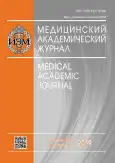НЕЙРОЭПИТЕЛИАЛЬНЫЕ ТЕЛЬЦА ЛЕГКОГО КРЫСЫ ПРИ ЭКСПЕРИМЕНТАЛЬНОЙ БРОНХИАЛЬНОЙ АСТМЕ
- Авторы: Сырцова МА1, Коржевский ДЭ1
-
Учреждения:
- ФГБНУ «Институт экспериментальной медицины»
- Выпуск: Том 19, № 1S (2019)
- Страницы: 43-44
- Раздел: Статьи
- Статья опубликована: 15.12.2019
- URL: https://journals.eco-vector.com/MAJ/article/view/19316
- ID: 19316
Цитировать
Полный текст
Аннотация
Эпителий дыхательных путей легких млекопитающих содержит легочные нейроэндокринные клетки, представленные как одиночными клетками, так и иннервированными кластерами образующие нейроэпителиальные тельца (НЭТ). Поскольку НЭТ интенсивно иннервируются и продуцируют высокоспецифичные биологически активные вещества, такие как бронхоконстриктор серотонин, уровень которого возрастает на фоне гипоксии, предполагается, что данные структуры могут играть одну из ключевых ролей в патогенезе бронхиальной астмы (БА).Целью настоящего исследования было выявление и анализ НЭТ в легких при экспериментальной БА.Для исследования использовались легкие половозрелых крыс Wistar (n = 5). НЭТ выявляли при помощи моноклональных антител к синаптофизину. Было установлено, что на фоне экспериментальной БА 76,6 % НЭТ были локализованы в составе однослойного кубического эпителия мелких бронхов и респираторных бронхиол. 17,6 % НЭТ были обнаружены в составе эпителиального пласта и только 5,8 % это одиночные НЭТ в составе эпителия мелких бронхов. При этом большее число НЭТ, локализованных в бронхах, состояли из 6 клеток (46,2 %), 38,5 % из 4 клеток и 15,3 % из более чем 10 клеток в одномкластере. Так же как и в предыдущих наших исследованиях, большинство НЭТ располагались вблизи синаптофизи-иммунопозитивных терминалей. На фоне БА происходило уменьшение количества крупных кластеров НЭТ, и увеличение скоплений НЭТ среднего размера. Полученные результаты свидетельствуют о влиянии воспаления на функциональные особенности нейроэндокринной системы легких и возможного, вклада НЭТ в воспалительный каскад при БА.
Ключевые слова
Полный текст
Об авторах
М А Сырцова
ФГБНУ «Институт экспериментальной медицины»
Д Э Коржевский
ФГБНУ «Институт экспериментальной медицины»
Список литературы
Дополнительные файлы







